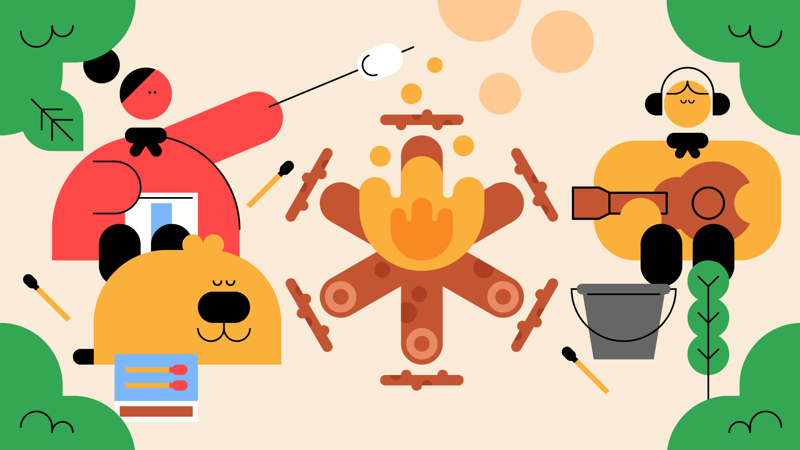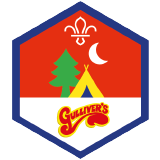
Fire star-ters
You’ll need
- Kindling (for example, small sticks)
- Tinder (for example, cotton balls and petroleum jelly)
- Firewood
- Fire lighter (for example, matches or ferro rod)
- Buckets
- Wooden skewers
- Marshmallows (optional)
Get ready for fire
- Choose an appropriate location for this activity; this could be a local campsite or outdoor area with the landowners' permission.
- Everyone should understand all the safety tips and how to deal with burns or cuts before you start.
- Split into small groups. Make sure everyone has enough space and a clear and safe area to light a fire.
Build a star fire
- Collect six seasoned or dry logs approximately 7cm thick, and a collection of smaller dry sticks of different sizes and thickness.
- Arrange the six large logs into a star shape that meets in the centre.
- Use three smaller sticks to build a tripod over the centre of the logs.
- Add more twigs about finger width around the tripod to make a wigwam shape.
- Leave one side open and place your tinder and kindling in the space. Keep adding more twigs of different sizes around the outside, leaving a gap to light the tinder.
Light your star fire
- Use a firelighter (such as a ferro rod) and remember that practice makes perfect.
- As the six larger logs burn down, push them further into the centre. Keep extra logs ready in case you need to refuel.
Toast your new skills (optional)
- Gather round the fire you've built and celebrate your achievements by putting a marshmallow on a skewer and toasting it over the flames.
Extinguish the fire
- Stop adding wood and wait for the fire to burn down and turn to ash.
- Pour water all over the fire.
- Stir the ashes with the stick to ensure all the embers are put out.
Leave no trace
- Tidy the fire area, returning it to the same condition it was in when you arrived.
- Replace any turf you moved.
Reflection
This activity helped you to value the outdoors. Did you enjoy being outside? How did the fire change your experience of being outdoors? How did you make sure your fire didn’t damage the outdoors? Did you feel comfortable being outside?
This activity has taught you a useful practical skill. While the fires you’ve built are dying down, you could reflect on our relationship with fire. Do you know more about fire now? What are some of the uses of fire? How have people used fire in the past? How do we use fire now? What are the dangers of fire? How can you prevent these dangers? What first aid skills should everyone have before dealing with fire?
Safety
All activities must be safely managed. You must complete a thorough risk assessment and take appropriate steps to reduce risk. Use the safety checklist to help you plan and risk assess your activity. Always get approval for the activity, and have suitable supervision and an InTouch process.
- Fires and stoves
Make sure anyone using fires and stoves is doing so safely. Check that the equipment and area are suitable and have plenty of ventilation. Follow the gas safety guidance. Have a safe way to extinguish the fire in an emergency.
- Cooking
Teach young people how to use cooking equipment safely. Supervise them appropriately throughout. Make sure it’s safe to use and follow manufacturers’ guidelines for use.
- Food
Remember to check for allergies, eating problems, fasting or dietary requirements and adjust the recipe as needed. Make sure you’ve suitable areas for storing and preparing food and avoid cross contamination of different foods. Take a look at our guidance on food safety and hygiene.
Plenty of activities can take place around the fire.
Why not try marshmallow toasting? Pop a marshmallow on a stick and hold it close to the fire. Avoid using small sticks for this – aim for sticks that are roughly be the length of an adult’s arm. Remember to allow time for the marshmallow to cool down before biting into it!
Once you’ve mastered the art of marshmallow toasting, you might be ready to create s’mores. Explore the delights of squishing a toasted marshmallow between two chocolate digestive biscuits for a campfire culinary delight. They’re so good you’ll want s’more!
Consider having an extra leader to float between groups and offer one-to-one support when needed. This activity could also be made accessible by starting a smaller fire in a metal biscuit tin – this could be easily controlled.
All Scout activities should be inclusive and accessible.


